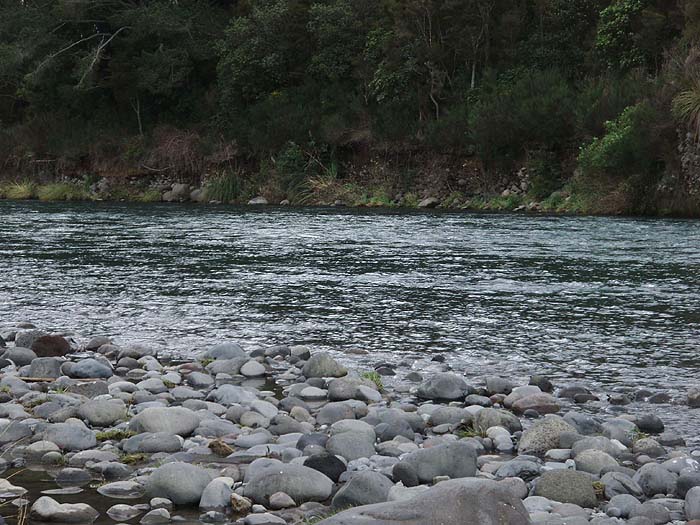 '
'Information Page.
Fishing in New Zealand.
My pal Alan Bulmer has been catching a few fish down under so here's the story. Alan's just as keen as Dave Baker (see latest 'Saltwater' page) and really works at all his fishing. As always his tale's full of entertaining and amusing anecdotes -
Hi Mike,
Glad to hear that everyone is fit and well in your neck of the woods. I visited the Operation Sea Angler website today and was pleased to see that you’ve been able to get out fishing over the past week. Regarding the weak head of the 'Slandra', have you tried coating the head with Bug Bond? I suspect that it will stop the head from coming adrift, especially if you coated the first centimetre of the head and made sure that the epoxy formed a seamless join with the hook.(MUST try that - will write to David Edwards ASAP)
We motored down to Turangi on Sunday 3 October in convoy. The further south we travelled the better the weather became. By the time we reached Te Rangiita the sun was out, the sky cloudless and the surface of the lake so still it resembled a sheet of glass. I quickly unpacked the car and set off to check the state of the Tauranga-Taupo, Waiotaka and Tongariro rivers. Unfortunately they were all still running high from the heavy rain on Friday but seemed to be dropping and clearing steadily. My feeling was that they would probably be ideal for fly fishing by Tuesday.
Returning in the late afternoon I quickly unpacked and assembled my fly fishing tackle for the week ahead. I decided to check out the rip where the Waitetoko stream entered Lake Taupo as it was a short 15 minute walk along the waterfront from where we were staying. When the rip is flowing directly into the lake (see photograph) then the trout move in close to feed, especially at dawn and dusk.
DAY ONE – “Rip, Sh*t and Bust”
I arrived at the rip at 4.00pm to find that it was flowing into the lake in a northerly direction at about 45o to the shoreline. This is not ideal. The stream also was the colour of heavily brewed tea (sans milk) and there was no mistaking the line of delineation between the crystal clear lake water and the tea stained inflow. The absence of wind made conditions ideal for a shakedown casting session. History suggests that it normally takes me around 1 – 1 ½ days to find a fly casting rhythm when I get to Turangi and reach the point where casting is purely instinctive so I had no expectation of catching fish immediately.
I attached an 9’ fluorocarbon trace, tied on an orange tungsten bead head nymph (top) and a green caddis nymph with a glass bead head about 8” below it on the point. Casting out along the edge of the rip I allowed the nymphs to sink and retrieved them slowly using the standard figure of 8 motion. My casting at first was decidedly rusty and it took around 30 minutes to eliminate the excessive false casting and find some sort of mechanical rhythm. By then I’d totally relaxed and was operating by instinct. I wasn’t touching the bottom so decided to allow a longer pause after the next cast to let the nymphs drift down deeper in the water column before I started retrieving. Three handfuls of line into the retrieve and the line stopped abruptly as a fish hit the flies hard. I uttered an expletive (Sh*t), struck fiercely in retaliation and watched the fly line sail harmlessly over my right shoulder. I reeled in to discover that I’d broken the trace where it was attached to the fly line. Obviously I’d have to unlearn my spinning strike technique fast, as 8 lb fluorocarbon is not the same as the braid and the 15lb Amnesia trace I use routinely on my spinning reels, else I’d be spending a lot of time re-rigging.
Nothing else happened for the next hour or so, other than a couple of trout head and tailing provocatively at the inside edge of the rip. This behaviour was obviously designed to put me off my casting stroke and improve my knot tying as I switched flies several times in a vain attempt to elicit a strike.
DAY TWO
Buoyed by my near miss at the Waitetoko the evening before, I was up early and at the stream mouth by 6.45 am. Unfortunately the rip had pushed further to the north overnight and was now running along the shore. This is next to useless and after an hour of fruitless casting I retired back to the bach for breakfast.
After breakfast I decided to try one of the smaller streams, the Waiotaka, as it seemed to be least affected by the flooding and was dropping fastest. When I reached the ford it was running high and was still highly coloured (snow melt aqua) which was far from ideal. I opted to try a tungsten beaded Hare's ear nymph with a green caddis nymph on point in an effort to get down deep in the shallow, calmer margins. The run above the ford looked like it may hold fish so I systematically started to fish it upstream. Half-a-dozen casts into the session the fly line stopped and I struck firmly. The fish swirled angrily in a silver flash and was gone. I reeled in my line to be greeted with a scale impaled on the bottom hook. Obviously the fish had taken the Hare's ear and I’d pinged it with the caddis on the strike. Too slow!
I fished up and down the river from the ford for about and hour or so unsuccessfully but the flow was too strong and there were very few holding lies other than the one that I’d started in. Sandy and her parents drove up as I returned to the ford and as I got to them we spotted a pair of jack rainbow trout fighting on the surface about 15 metres below where I’d hooked up initially. They disappeared in a flurry of foam and neither would take any of the flies that I subsequently drifted through the lie.
I returned home for lunch and readied myself for another try in the Waitetoko rip. This time I went fishing with a spade. When I was young Ivan used to dig the stream straight into the lake, leave it for a couple of hours and then fish from the change of light. It didn’t take long to adjust the inflow but I did not have time to wait and started fishing immediately. Nothing came to my flies over the next hour or so but I did have my casting action captured for posterity by an amateur photographer. He wanted my silhouette against the sunset and I was pleased to oblige.
DAY THREE
My friend Tony Prichard was scheduled to arrive at 8.00 am from Hastings so I opted to fish the Waitetoko rip from 6.45 am until he arrived. The thermometer registered 1oC when I left the bach and walked to the rip. The grass was crisp with frost but the eerie calm indicated that it was going to be a stunning spring day. When I got to the rip it was running straight into the lake and had obviously being doing so since the previous evening. I’d figured out that I may not have been getting deep enough so I lengthened my cast to 14’ and attached a tungsten bead pheasant tail nymph and a small Glo-bug on the point.
Third cast along the edge of the rip and the line stopped. I strip struck and was rewarded by the aggressive surging run of a decent trout. It hit the air almost immediately and splashed back down heavily into the rip. Next it tore out into the centre of the lake on a withering 40 metre burst. I managed to turn it with side strain and then it opted to charge back up into the rip with me reeling frantically to collect the slack. Eventually I gained a modicum of control and was able to get it to stay within 30 metres of the shore and running parallel through the rip. Three runs and another couple of jumps later it lay exhausted on the shore and was easily beached. It was a 3.5lb Rainbow jack and was in excellent condition (see photograph).
I carried on for another 20 minutes and then went home for breakfast. Fortunately I had time to gut, split and salt the fish for smoking before Tony arrived. After a cup of coffee and a chat to catch up on the gossip we formulated a plan and were off. Our best option seemed to be the Tauranga-Taupo river as, even though it was still high, it was clearing quickly and starting to drop. Hamish tagged along to sketch and paint while Tony and I fished. We walked about 4 kilometres up and down the river over the next 2½ hours but did not touch a fish between us. It was virgin water for Tony and it was far higher than when I’d last fished it so we were in essence fishing blind. In hindsight, I suspect that we were not fishing deep enough on account of the extra flow and not covering the most likely lies thoroughly.
After lunch Tony suggested that we fish a run called Boulder Reach on the Tongariro as it was a reliable stretch which regularly yielded fish under these sort of conditions. When we arrived at the run there was a party of six fishermen already fishing it in a constant rota. Cast, move two steps upstream, cast... When they reached the top of the run they exited and went to the bottom to start over again. They graciously allowed us to enter into the sequence and Tony waded in while I rigged up and Hamish set up to paint. Tony had not had more than three or four casts when his indicator dipped and he was fast into a fish. Unfortunately it was a mending slab and was easily worked into the margin for release. While Tony was out on the bank another fisherman (above him in the queue) hooked fish in three successive casts and landed them all. Each was about 2½ lb but their condition was variable. Tony and I re-entered the run but did not have any more touches on our way up the beat. Again I suspect that my flies were not getting deep enough as I did not hook the bottom at all. The general rule is that you have to be losing flies on the bottom regularly to be sure that you are in the zone.
By now it was getting on so we opted to pack up and briefly fish another stretch of the Tongariro under the main highway bridge before going home for dinner. No joy.
DAY FOUR
Tony was staying in Turangi and was up and on the river under the bridge by 5.45 am. I strolled down to the Waitetoko rip at 6.45 am but it was flowing parallel to the shore so I again drew a blank. Should have brought my spade! When I caught up with Tony at 8.00 am he had two fish on the bank and had returned three more. By all accounts he was hitting a fish every 20 minutes initially and there were lots of fish holding in the run.
After Tony had dropped his fish off, we opted to fish in the Hydro pool which is at the southern end of Turangi township on the Tongariro. Tony started in the honey hole and he moved steadily up the run ensuring that his nymphs searched out every nook and cranny (see photographs – Hydro pool and Tony at play). I let him get about 15 metres ahead before entering the tail of the run. Learning from yesterday, I lengthened my trace to 10’ and added splitshot above my tungsten bead head to get the fly down quickly. Casting finesse disappears out the window with this sort of rig and the flies are lobbed upstream sidearm. If you cast normally then you have to slow down the casting stroke and duck on the delivery cast else you end up catching yourself on the back of the scone.
First cast in the Hydro pool was promising. The indicator was vibrating on the surface madly as the flies bounced along the bottom. Second cast was identical but as the flies got to 10 O’clock downstream the indicator disappeared. I strip struck and came up hard onto a feisty trout. The fish was small (2.5 lb) but gave an excellent account of itself in the shallow water. It was a maiden hen and had entered the river within the last 48 hours as it was still bright silver (see photograph).
Tony opted to leave at 11.00 am as he had not had any touches and go across to Lake Otamangakau on the way home whereas I fished on until 11.20 am. There were several fish caught by other anglers during this period but my indicator and flies remained unmolested.
DAY FIVE
Sandy and I decided to fish the Tauranga-Taupo river but that a later, more leisurely start was in order. We reached the river at 8.30 am and made our way to the first fishable pool on the true left bank. This involved negotiating a boggy section of marsh grass in a backwater and Sandy proceeded to get stuck. I retraced my steps to assist and ended up falling sideways into the muddiest part as it grabbed me around the ankles in a vice like grip. It was just like a scene from a black and white Keystone cops silent movie. Luckily my waders deflected most of the ooze but I still had mud up one arm to the elbow. As you can imagine, this incident did not improve my humour and I fished the first run like a one armed paper hanger.
Gradually the mud dried and by the time we crossed the river the warm sun had done a marvellous job in lifting our spirits. I managed to winkle a fingerling out of the next run and things were all of a sudden starting to get much more interesting. By the time we’d fished the next stretch the sun was well up and the conditions were glorious. The only down side was that I’d managed to clout myself on the back of the scone with my split shot and tungsten beaded nymph combo a couple of times despite bobbing down religiously in the delivery cast.
The next run screamed fish. It held fish over the summer and we’d seen an angler land one earlier in the week. I worked my way up the true right bank until I reached a willow “bush” and then was forced to roll cast to fish the lie. What a revelation. The roll cast technique kept the flies in front of me so the chance of sconning myself was nonexistent. Brilliant! I changed the top beaded nymph back to an Orange roe imitation and added another weighted nymph at the point. Fourth cast through the lie and the indicator was wrenched under the water. I struck hard and the fish careered out of the run into the willow roots at my feet. I desperately pulled in the slack line only for the fish to rocket back into the current when everything again came up tight. It then turned on its tail and came back towards me and spat the hook at my feet.
I opted to rest the lie for 10 minutes and fish above the willow bush. I was roll casting furiously by now and getting nicely into the groove. Sandy was watching so I tried to do a longer cast and proceeded to slip off the edge of the gravel bank and land abruptly on my derriere in a cloud of dust. Not my day! After a quiet period of reflection I returned to the run downstream of the willow bush and resumed roll casting. Half-a-dozen casts later and the indicator again scythed underwater. I struck hard and the fish took off upstream. I managed to turn its head with side pressure and then it took to the air. Crashing back into the run it careered about for five minutes in a fierce tug of war. Eventually I was able to work it into the shore. Sandy was keen to net it so she headed down the steep scree bank to intercept. Every time she got to the edge the fish headed back out into midstream. I’d work it into the bank again 10 metres downstream, she’d catch up, and then it would charge off as she approached. This happen four times before the fish lay flapping in the margins exhausted. Sandy was panting hard out from going up and down the scree by now and I was doubled up in stitches trying not to wet myself. It was a beautiful 3 lb maiden hen fish (see photograph) and shone like an ingot of freshly minted silver in the sun. We decided to give up at this point and made our way home for lunch, via the boggy section!
DAY SIX
Hamish and I hit the Tauranga-Taupo again at 8.00 am. We met a local in the car park who suggested only fishing one fly. The fly was located about 6” below a blood knot. Above the blood knot was a 1/6 oz split shot. The trace was only 9’ long but the fly sure got down to the bottom. I rigged this set up for Hamish and he fished it all morning without so much as a touch. I blanked as well. The downside of the morning was an altercation with four ignorant anglers who disregarded the established rules of fishing etiquette and charged into both pools that Hamish and I were fishing ahead of us. I said nothing but struck a “teapot” pose and glared furiously. One of the anglers grabbed a huge rock and threw it into the water behind me to disturb all of the fish in a deliberate act of provocation. I ignored the taunt and started casting at which point the perpetrator fled the scene. After this Hamish and I had a discussion and decided to fish the next run and go home early.
All in all it was a brilliant week. Really enjoyed catching up with Tony and fishing with Sandy and Hamish. Tony and I have arranged to meet up again soon at Turangi and terrorise the trout before vintage.
Tight lines and best wishes,
Alan Bulmer
It sounds like a lovely place to fish. I think that all this heavy nymph business would see me with countless flies embedded in the back of my neck and ears, although I could probably manage some sort of roll cast.
If you have any comments or questions about fish, methods, tactics or 'what have you.'get in touch with me by sending an E-MAIL to - docladle@hotmail.com
Hydro pool on Tongariro.
 '
'Tony fishing.
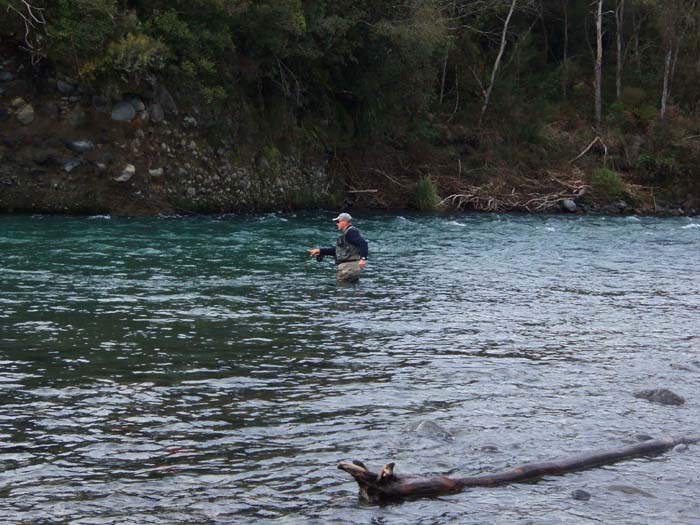 '
'Waitetoko rip.
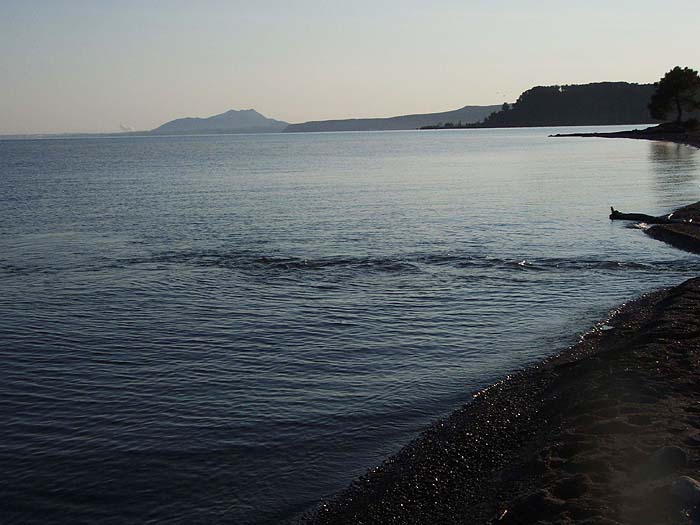 '
'Tongariro hen.
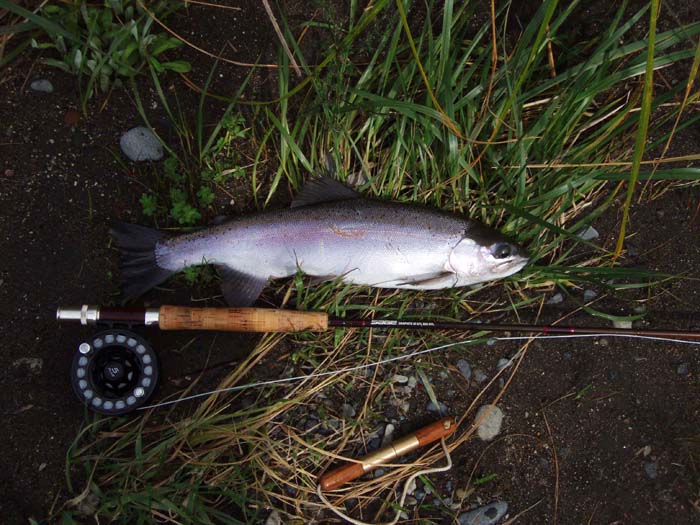 '
'Tauranga Taupo hen.
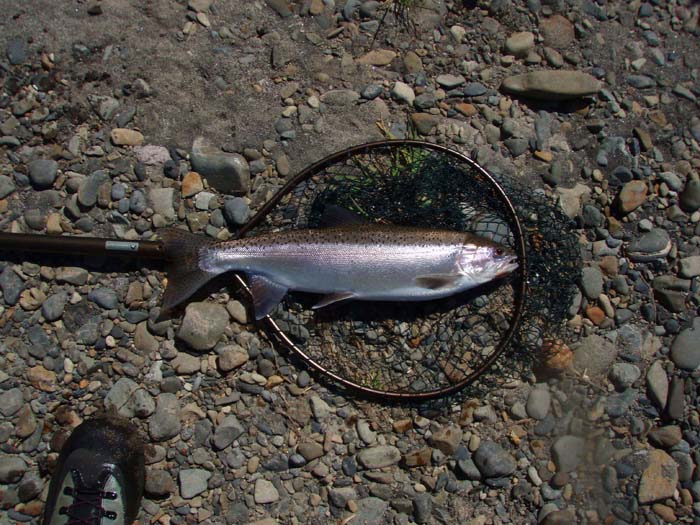 '
'Rip caught.
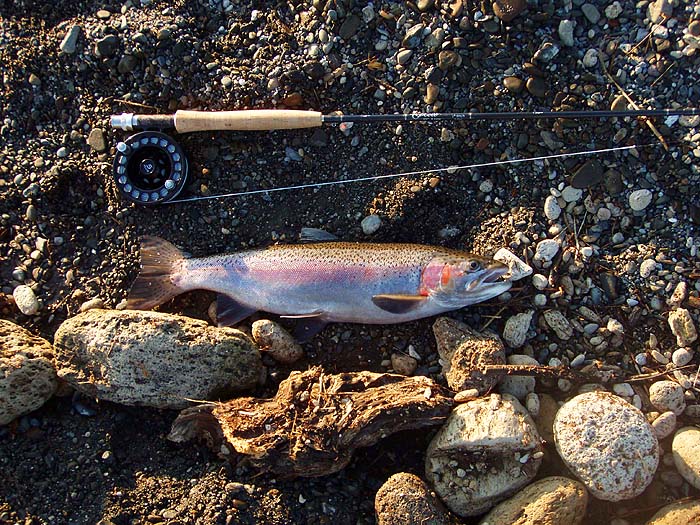 '
'